HLTENN006: Apply Principles of Wound Management Assignment
VerifiedAdded on 2023/01/12
|29
|5786
|42
Homework Assignment
AI Summary
This assignment solution addresses various aspects of wound management, aligning with the HLTENN006 curriculum for Diploma of Nursing students. The document covers wound healing stages (hemostasis, inflammation, proliferation, maturation), and associated care strategies. It also includes complex wound management considerations, primary healthcare principles in wound care, and the National Safety and Quality Health Service Standards. The assignment further explores the chain of infection, aseptic techniques, and the rationale behind specific wound care practices. It also includes signs and symptoms of wound infection, historical events, and components of WHIA services. The solution encompasses wound pain management, wound infection examples, and detailed wound assessment techniques (photography, tracing, linear measurement). The assignment concludes with wound debridement, drainage systems, specimen types, and the relationship between hematology lab tests and wound healing. Overall, it provides a comprehensive overview of wound care principles and practices.
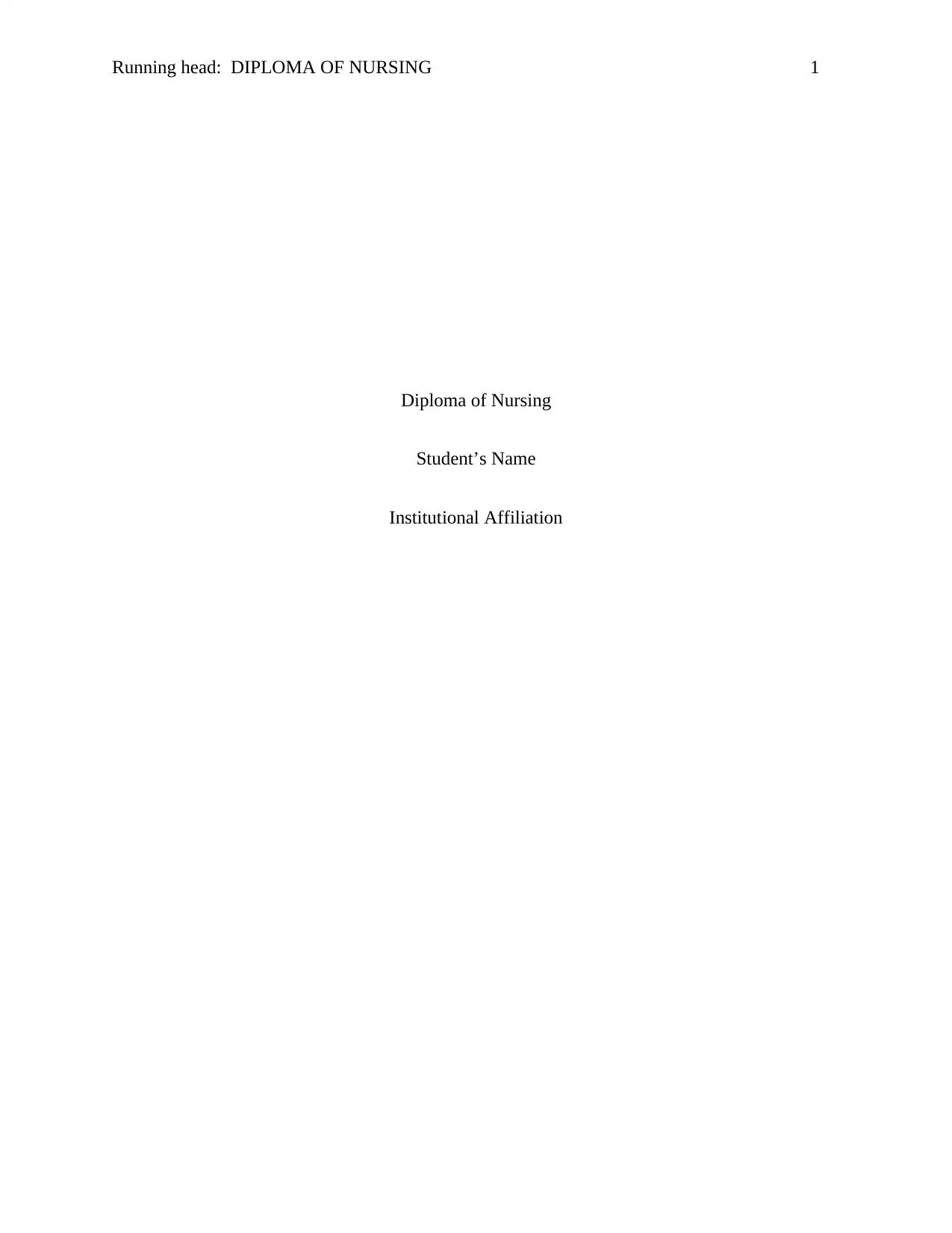
Running head: DIPLOMA OF NURSING 1
Diploma of Nursing
Student’s Name
Institutional Affiliation
Diploma of Nursing
Student’s Name
Institutional Affiliation
Paraphrase This Document
Need a fresh take? Get an instant paraphrase of this document with our AI Paraphraser
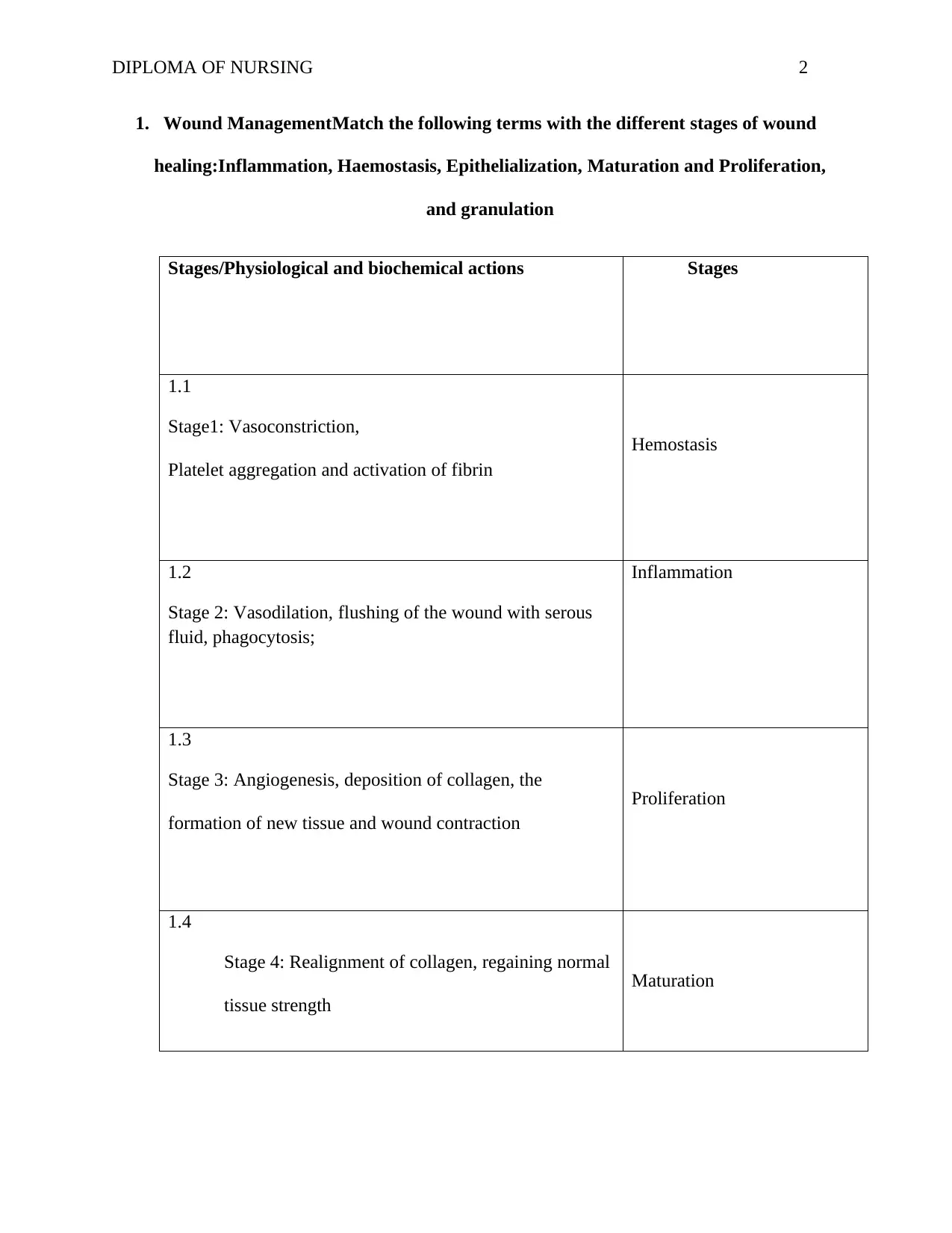
DIPLOMA OF NURSING 2
1. Wound ManagementMatch the following terms with the different stages of wound
healing:Inflammation, Haemostasis, Epithelialization, Maturation and Proliferation,
and granulation
Stages/Physiological and biochemical actions Stages
1.1
Stage1: Vasoconstriction,
Platelet aggregation and activation of fibrin
Hemostasis
1.2
Stage 2: Vasodilation, flushing of the wound with serous
fluid, phagocytosis;
Inflammation
1.3
Stage 3: Angiogenesis, deposition of collagen, the
formation of new tissue and wound contraction
Proliferation
1.4
Stage 4: Realignment of collagen, regaining normal
tissue strength
Maturation
1. Wound ManagementMatch the following terms with the different stages of wound
healing:Inflammation, Haemostasis, Epithelialization, Maturation and Proliferation,
and granulation
Stages/Physiological and biochemical actions Stages
1.1
Stage1: Vasoconstriction,
Platelet aggregation and activation of fibrin
Hemostasis
1.2
Stage 2: Vasodilation, flushing of the wound with serous
fluid, phagocytosis;
Inflammation
1.3
Stage 3: Angiogenesis, deposition of collagen, the
formation of new tissue and wound contraction
Proliferation
1.4
Stage 4: Realignment of collagen, regaining normal
tissue strength
Maturation

DIPLOMA OF NURSING 3
2. Give one example of a wound care product or strategy that helps with each stage of
wound healing.
Stages Wound care product or strategy
2.1
Hemostasis
Chitosan dressings
2.2
Inflammation
Polymeric membrane dressings
2.3
Proliferation and granulation
Collagen Dressings
2.4
Epithelialization and Maturation
Allogeneic cultured keratinocyte grafts
3. Complex Wounds
List five common problems to be considered in the management of complex wounds?
Wound size, body contours, the expense of complex wounds should be considered. Also,
poor nutrition, along with insufficient blood flow to the injury needs to be considered.
2. Give one example of a wound care product or strategy that helps with each stage of
wound healing.
Stages Wound care product or strategy
2.1
Hemostasis
Chitosan dressings
2.2
Inflammation
Polymeric membrane dressings
2.3
Proliferation and granulation
Collagen Dressings
2.4
Epithelialization and Maturation
Allogeneic cultured keratinocyte grafts
3. Complex Wounds
List five common problems to be considered in the management of complex wounds?
Wound size, body contours, the expense of complex wounds should be considered. Also,
poor nutrition, along with insufficient blood flow to the injury needs to be considered.
⊘ This is a preview!⊘
Do you want full access?
Subscribe today to unlock all pages.

Trusted by 1+ million students worldwide
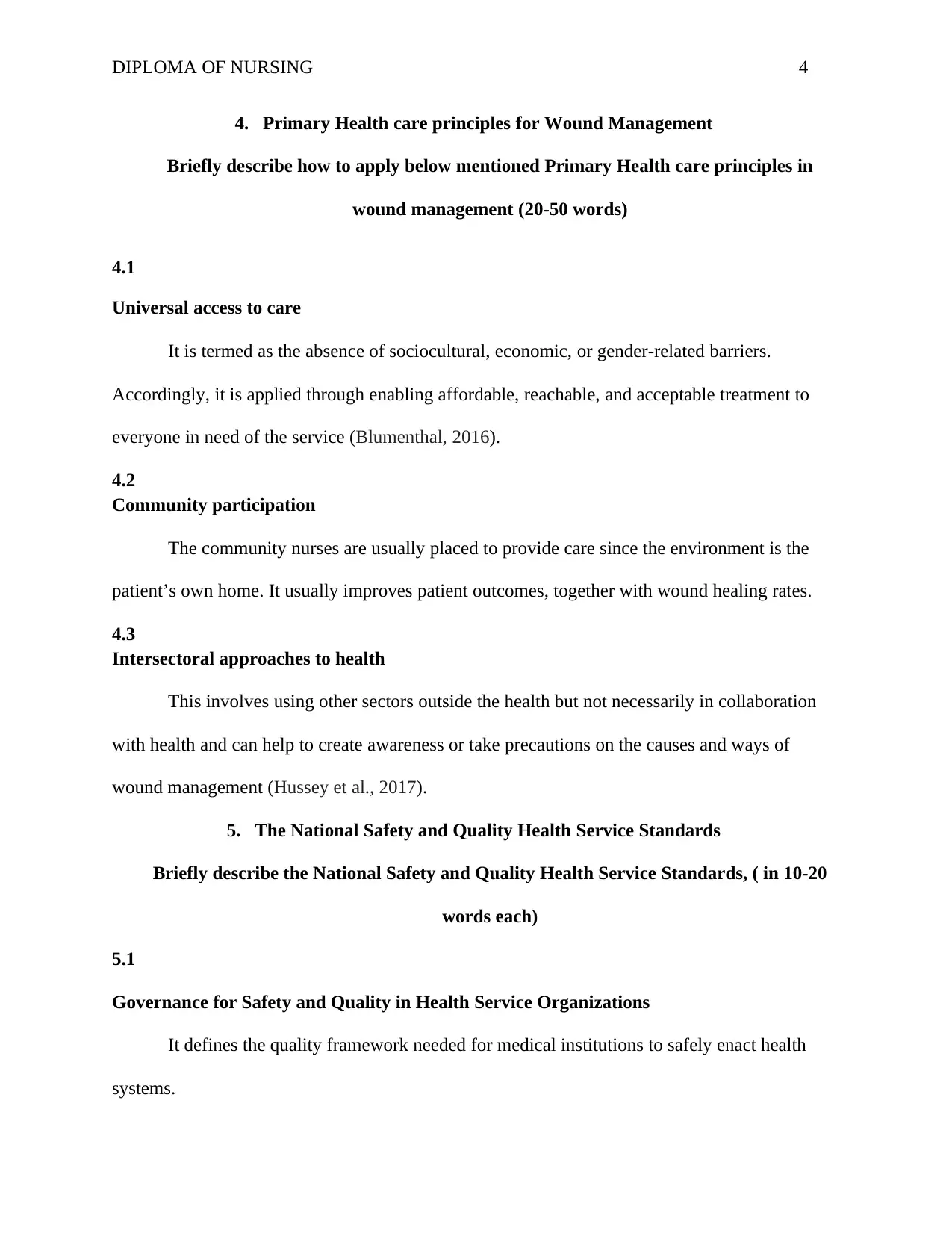
DIPLOMA OF NURSING 4
4. Primary Health care principles for Wound Management
Briefly describe how to apply below mentioned Primary Health care principles in
wound management (20-50 words)
4.1
Universal access to care
It is termed as the absence of sociocultural, economic, or gender-related barriers.
Accordingly, it is applied through enabling affordable, reachable, and acceptable treatment to
everyone in need of the service (Blumenthal, 2016).
4.2
Community participation
The community nurses are usually placed to provide care since the environment is the
patient’s own home. It usually improves patient outcomes, together with wound healing rates.
4.3
Intersectoral approaches to health
This involves using other sectors outside the health but not necessarily in collaboration
with health and can help to create awareness or take precautions on the causes and ways of
wound management (Hussey et al., 2017).
5. The National Safety and Quality Health Service Standards
Briefly describe the National Safety and Quality Health Service Standards, ( in 10-20
words each)
5.1
Governance for Safety and Quality in Health Service Organizations
It defines the quality framework needed for medical institutions to safely enact health
systems.
4. Primary Health care principles for Wound Management
Briefly describe how to apply below mentioned Primary Health care principles in
wound management (20-50 words)
4.1
Universal access to care
It is termed as the absence of sociocultural, economic, or gender-related barriers.
Accordingly, it is applied through enabling affordable, reachable, and acceptable treatment to
everyone in need of the service (Blumenthal, 2016).
4.2
Community participation
The community nurses are usually placed to provide care since the environment is the
patient’s own home. It usually improves patient outcomes, together with wound healing rates.
4.3
Intersectoral approaches to health
This involves using other sectors outside the health but not necessarily in collaboration
with health and can help to create awareness or take precautions on the causes and ways of
wound management (Hussey et al., 2017).
5. The National Safety and Quality Health Service Standards
Briefly describe the National Safety and Quality Health Service Standards, ( in 10-20
words each)
5.1
Governance for Safety and Quality in Health Service Organizations
It defines the quality framework needed for medical institutions to safely enact health
systems.
Paraphrase This Document
Need a fresh take? Get an instant paraphrase of this document with our AI Paraphraser
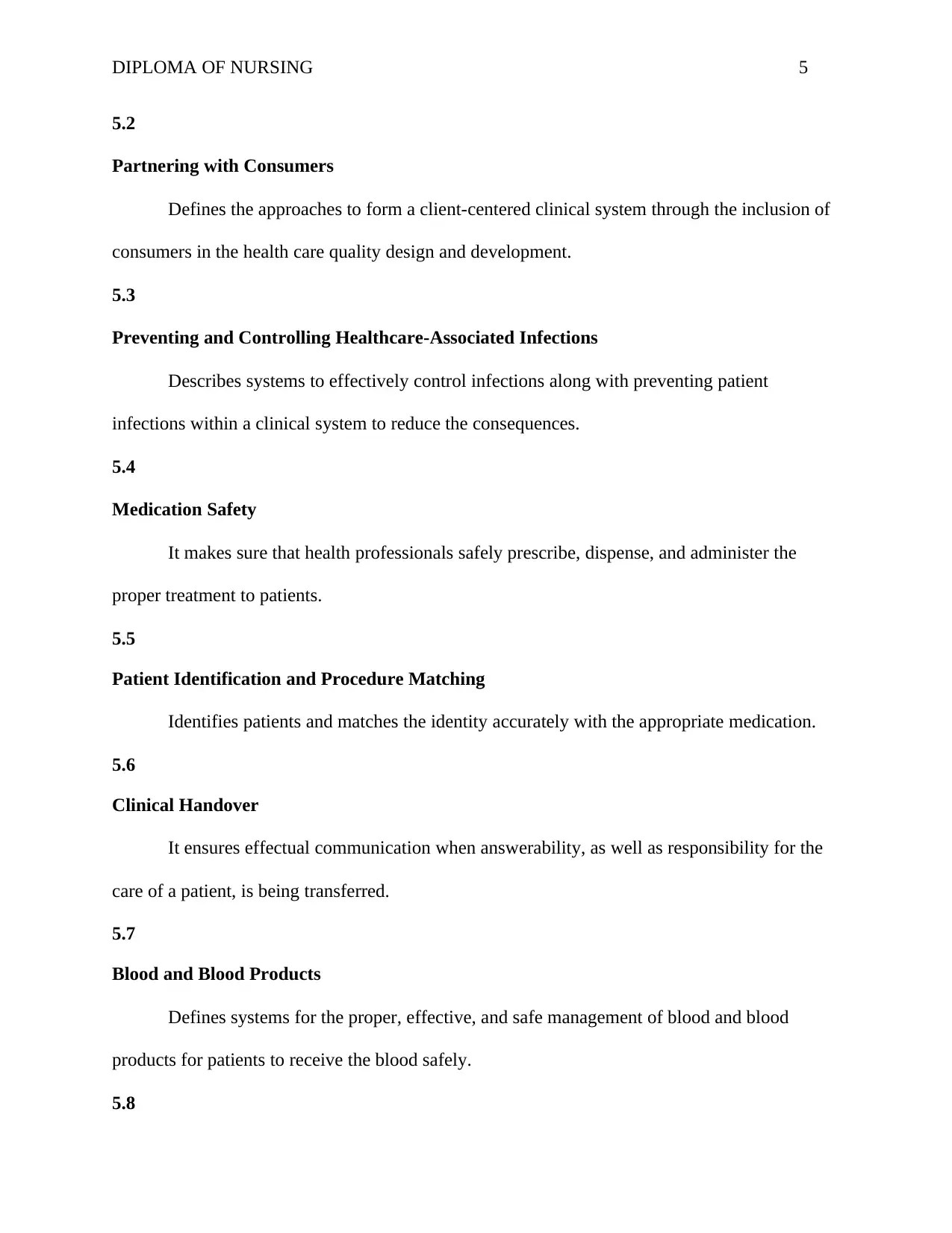
DIPLOMA OF NURSING 5
5.2
Partnering with Consumers
Defines the approaches to form a client-centered clinical system through the inclusion of
consumers in the health care quality design and development.
5.3
Preventing and Controlling Healthcare-Associated Infections
Describes systems to effectively control infections along with preventing patient
infections within a clinical system to reduce the consequences.
5.4
Medication Safety
It makes sure that health professionals safely prescribe, dispense, and administer the
proper treatment to patients.
5.5
Patient Identification and Procedure Matching
Identifies patients and matches the identity accurately with the appropriate medication.
5.6
Clinical Handover
It ensures effectual communication when answerability, as well as responsibility for the
care of a patient, is being transferred.
5.7
Blood and Blood Products
Defines systems for the proper, effective, and safe management of blood and blood
products for patients to receive the blood safely.
5.8
5.2
Partnering with Consumers
Defines the approaches to form a client-centered clinical system through the inclusion of
consumers in the health care quality design and development.
5.3
Preventing and Controlling Healthcare-Associated Infections
Describes systems to effectively control infections along with preventing patient
infections within a clinical system to reduce the consequences.
5.4
Medication Safety
It makes sure that health professionals safely prescribe, dispense, and administer the
proper treatment to patients.
5.5
Patient Identification and Procedure Matching
Identifies patients and matches the identity accurately with the appropriate medication.
5.6
Clinical Handover
It ensures effectual communication when answerability, as well as responsibility for the
care of a patient, is being transferred.
5.7
Blood and Blood Products
Defines systems for the proper, effective, and safe management of blood and blood
products for patients to receive the blood safely.
5.8
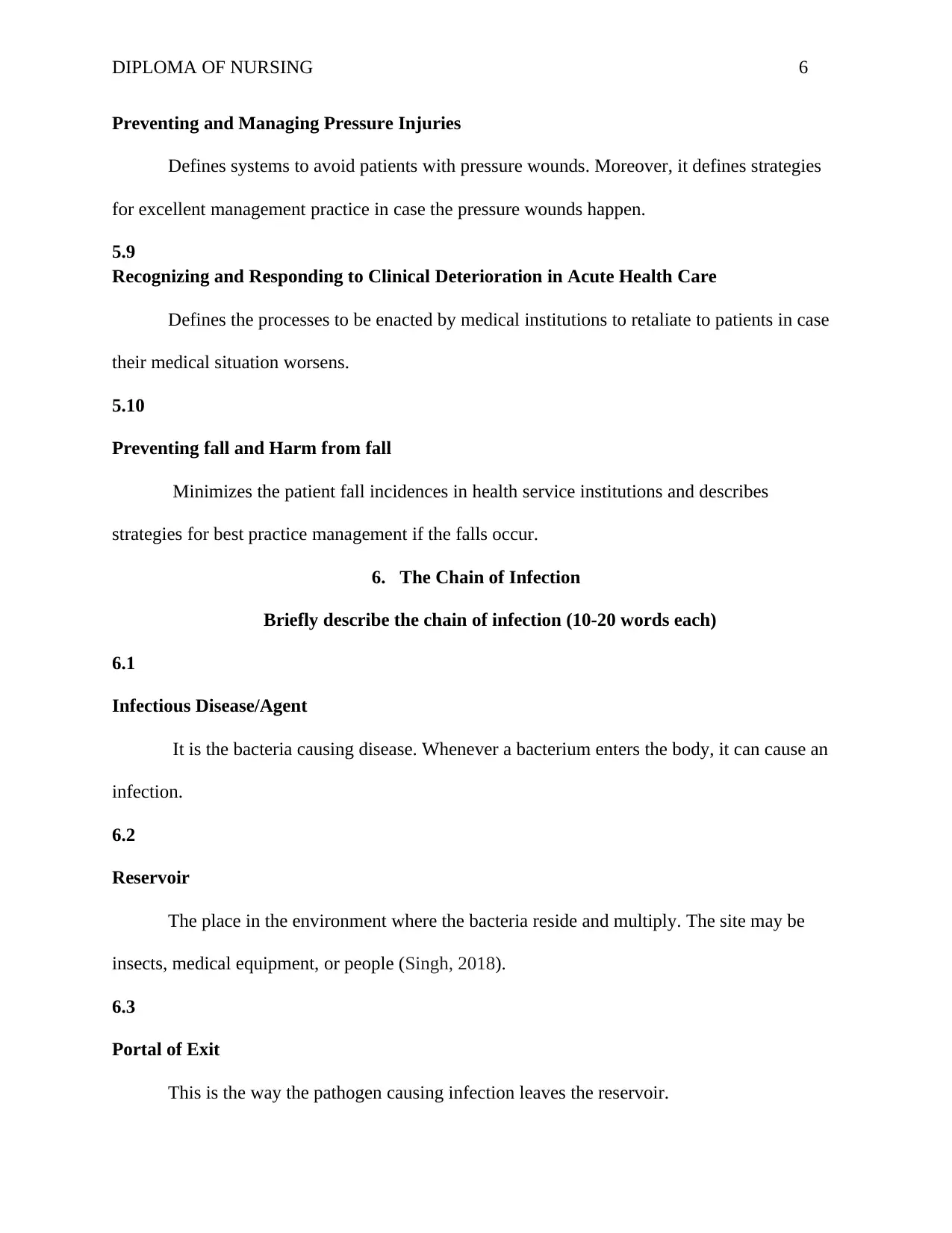
DIPLOMA OF NURSING 6
Preventing and Managing Pressure Injuries
Defines systems to avoid patients with pressure wounds. Moreover, it defines strategies
for excellent management practice in case the pressure wounds happen.
5.9
Recognizing and Responding to Clinical Deterioration in Acute Health Care
Defines the processes to be enacted by medical institutions to retaliate to patients in case
their medical situation worsens.
5.10
Preventing fall and Harm from fall
Minimizes the patient fall incidences in health service institutions and describes
strategies for best practice management if the falls occur.
6. The Chain of Infection
Briefly describe the chain of infection (10-20 words each)
6.1
Infectious Disease/Agent
It is the bacteria causing disease. Whenever a bacterium enters the body, it can cause an
infection.
6.2
Reservoir
The place in the environment where the bacteria reside and multiply. The site may be
insects, medical equipment, or people (Singh, 2018).
6.3
Portal of Exit
This is the way the pathogen causing infection leaves the reservoir.
Preventing and Managing Pressure Injuries
Defines systems to avoid patients with pressure wounds. Moreover, it defines strategies
for excellent management practice in case the pressure wounds happen.
5.9
Recognizing and Responding to Clinical Deterioration in Acute Health Care
Defines the processes to be enacted by medical institutions to retaliate to patients in case
their medical situation worsens.
5.10
Preventing fall and Harm from fall
Minimizes the patient fall incidences in health service institutions and describes
strategies for best practice management if the falls occur.
6. The Chain of Infection
Briefly describe the chain of infection (10-20 words each)
6.1
Infectious Disease/Agent
It is the bacteria causing disease. Whenever a bacterium enters the body, it can cause an
infection.
6.2
Reservoir
The place in the environment where the bacteria reside and multiply. The site may be
insects, medical equipment, or people (Singh, 2018).
6.3
Portal of Exit
This is the way the pathogen causing infection leaves the reservoir.
⊘ This is a preview!⊘
Do you want full access?
Subscribe today to unlock all pages.

Trusted by 1+ million students worldwide
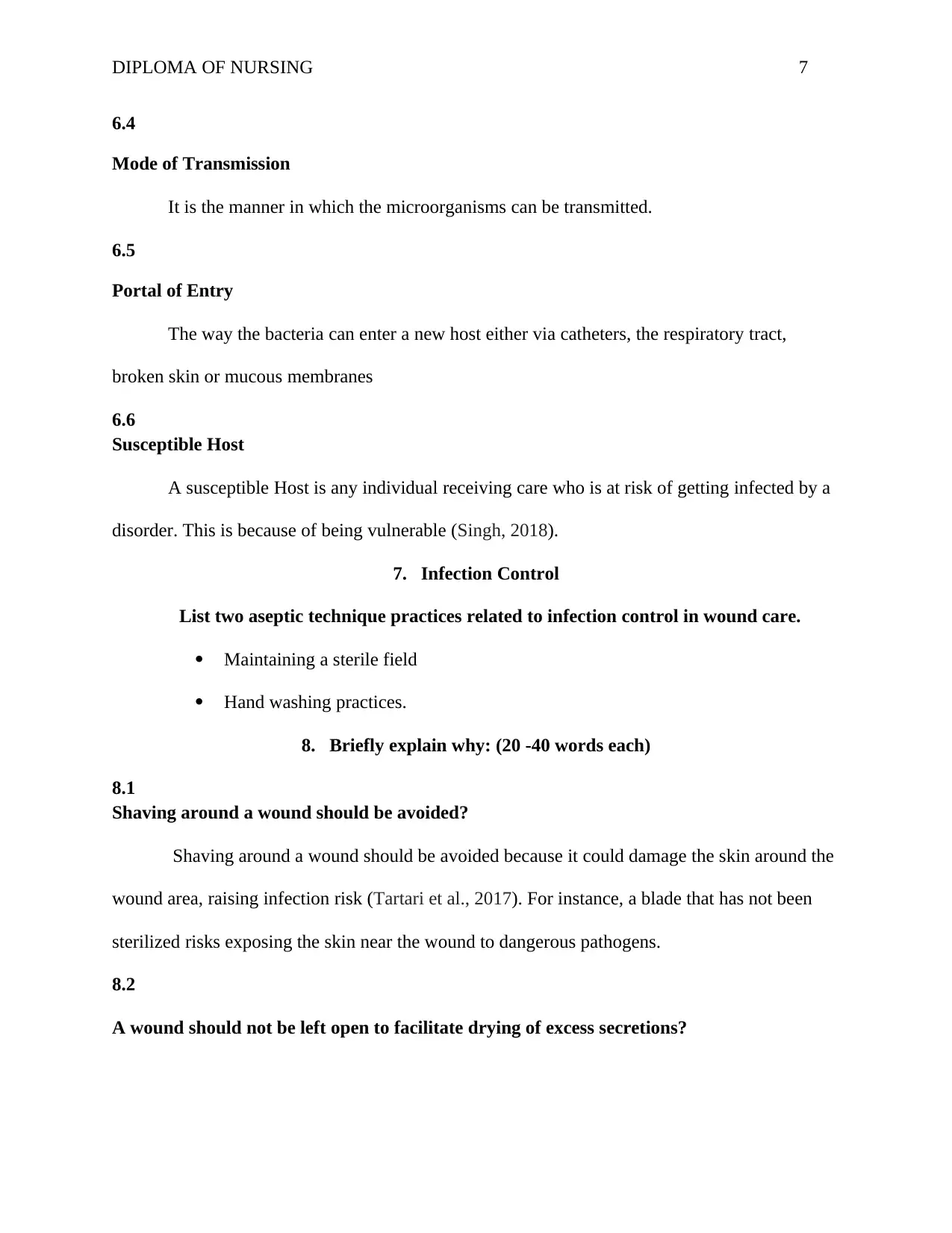
DIPLOMA OF NURSING 7
6.4
Mode of Transmission
It is the manner in which the microorganisms can be transmitted.
6.5
Portal of Entry
The way the bacteria can enter a new host either via catheters, the respiratory tract,
broken skin or mucous membranes
6.6
Susceptible Host
A susceptible Host is any individual receiving care who is at risk of getting infected by a
disorder. This is because of being vulnerable (Singh, 2018).
7. Infection Control
List two aseptic technique practices related to infection control in wound care.
Maintaining a sterile field
Hand washing practices.
8. Briefly explain why: (20 -40 words each)
8.1
Shaving around a wound should be avoided?
Shaving around a wound should be avoided because it could damage the skin around the
wound area, raising infection risk (Tartari et al., 2017). For instance, a blade that has not been
sterilized risks exposing the skin near the wound to dangerous pathogens.
8.2
A wound should not be left open to facilitate drying of excess secretions?
6.4
Mode of Transmission
It is the manner in which the microorganisms can be transmitted.
6.5
Portal of Entry
The way the bacteria can enter a new host either via catheters, the respiratory tract,
broken skin or mucous membranes
6.6
Susceptible Host
A susceptible Host is any individual receiving care who is at risk of getting infected by a
disorder. This is because of being vulnerable (Singh, 2018).
7. Infection Control
List two aseptic technique practices related to infection control in wound care.
Maintaining a sterile field
Hand washing practices.
8. Briefly explain why: (20 -40 words each)
8.1
Shaving around a wound should be avoided?
Shaving around a wound should be avoided because it could damage the skin around the
wound area, raising infection risk (Tartari et al., 2017). For instance, a blade that has not been
sterilized risks exposing the skin near the wound to dangerous pathogens.
8.2
A wound should not be left open to facilitate drying of excess secretions?
Paraphrase This Document
Need a fresh take? Get an instant paraphrase of this document with our AI Paraphraser
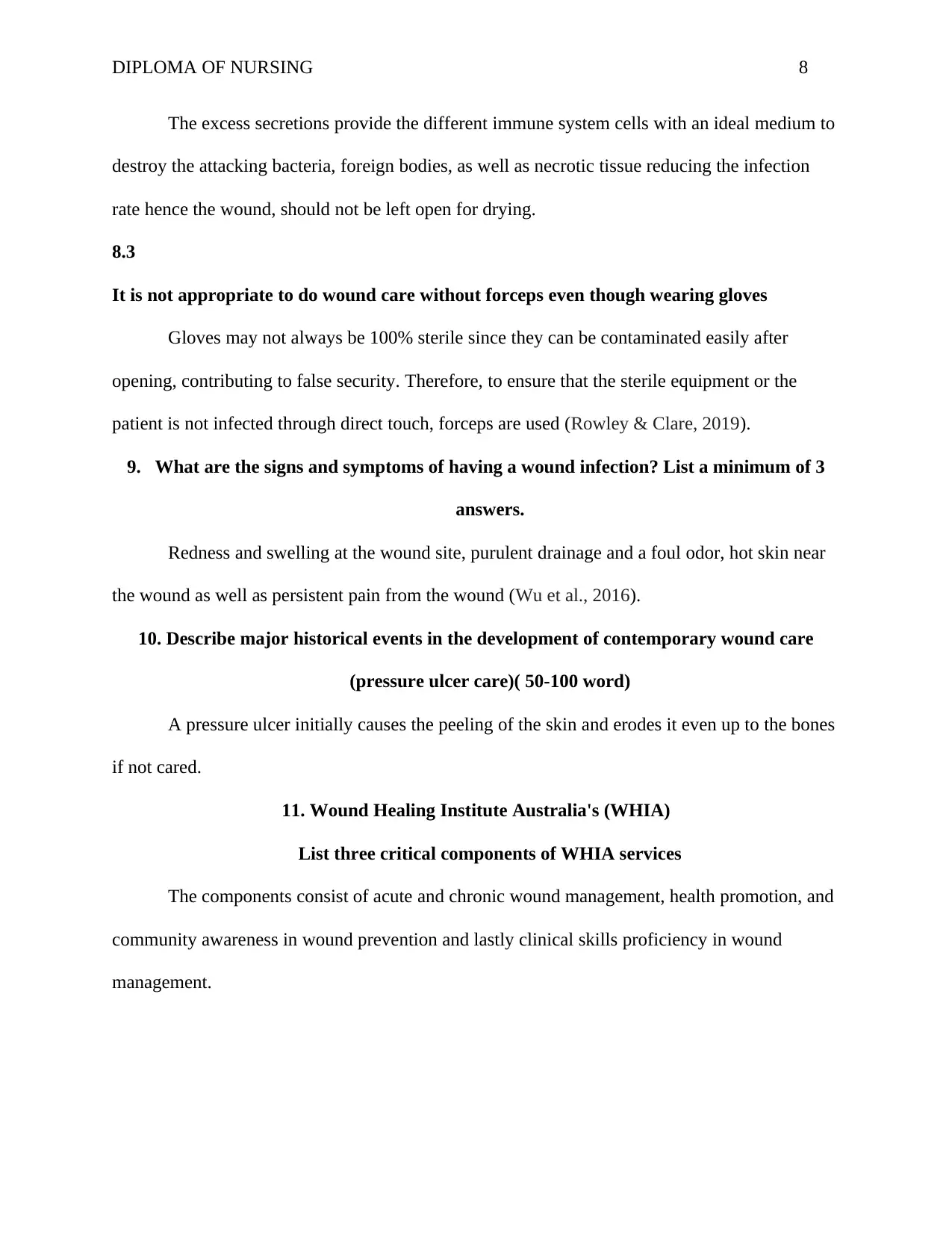
DIPLOMA OF NURSING 8
The excess secretions provide the different immune system cells with an ideal medium to
destroy the attacking bacteria, foreign bodies, as well as necrotic tissue reducing the infection
rate hence the wound, should not be left open for drying.
8.3
It is not appropriate to do wound care without forceps even though wearing gloves
Gloves may not always be 100% sterile since they can be contaminated easily after
opening, contributing to false security. Therefore, to ensure that the sterile equipment or the
patient is not infected through direct touch, forceps are used (Rowley & Clare, 2019).
9. What are the signs and symptoms of having a wound infection? List a minimum of 3
answers.
Redness and swelling at the wound site, purulent drainage and a foul odor, hot skin near
the wound as well as persistent pain from the wound (Wu et al., 2016).
10. Describe major historical events in the development of contemporary wound care
(pressure ulcer care)( 50-100 word)
A pressure ulcer initially causes the peeling of the skin and erodes it even up to the bones
if not cared.
11. Wound Healing Institute Australia's (WHIA)
List three critical components of WHIA services
The components consist of acute and chronic wound management, health promotion, and
community awareness in wound prevention and lastly clinical skills proficiency in wound
management.
The excess secretions provide the different immune system cells with an ideal medium to
destroy the attacking bacteria, foreign bodies, as well as necrotic tissue reducing the infection
rate hence the wound, should not be left open for drying.
8.3
It is not appropriate to do wound care without forceps even though wearing gloves
Gloves may not always be 100% sterile since they can be contaminated easily after
opening, contributing to false security. Therefore, to ensure that the sterile equipment or the
patient is not infected through direct touch, forceps are used (Rowley & Clare, 2019).
9. What are the signs and symptoms of having a wound infection? List a minimum of 3
answers.
Redness and swelling at the wound site, purulent drainage and a foul odor, hot skin near
the wound as well as persistent pain from the wound (Wu et al., 2016).
10. Describe major historical events in the development of contemporary wound care
(pressure ulcer care)( 50-100 word)
A pressure ulcer initially causes the peeling of the skin and erodes it even up to the bones
if not cared.
11. Wound Healing Institute Australia's (WHIA)
List three critical components of WHIA services
The components consist of acute and chronic wound management, health promotion, and
community awareness in wound prevention and lastly clinical skills proficiency in wound
management.
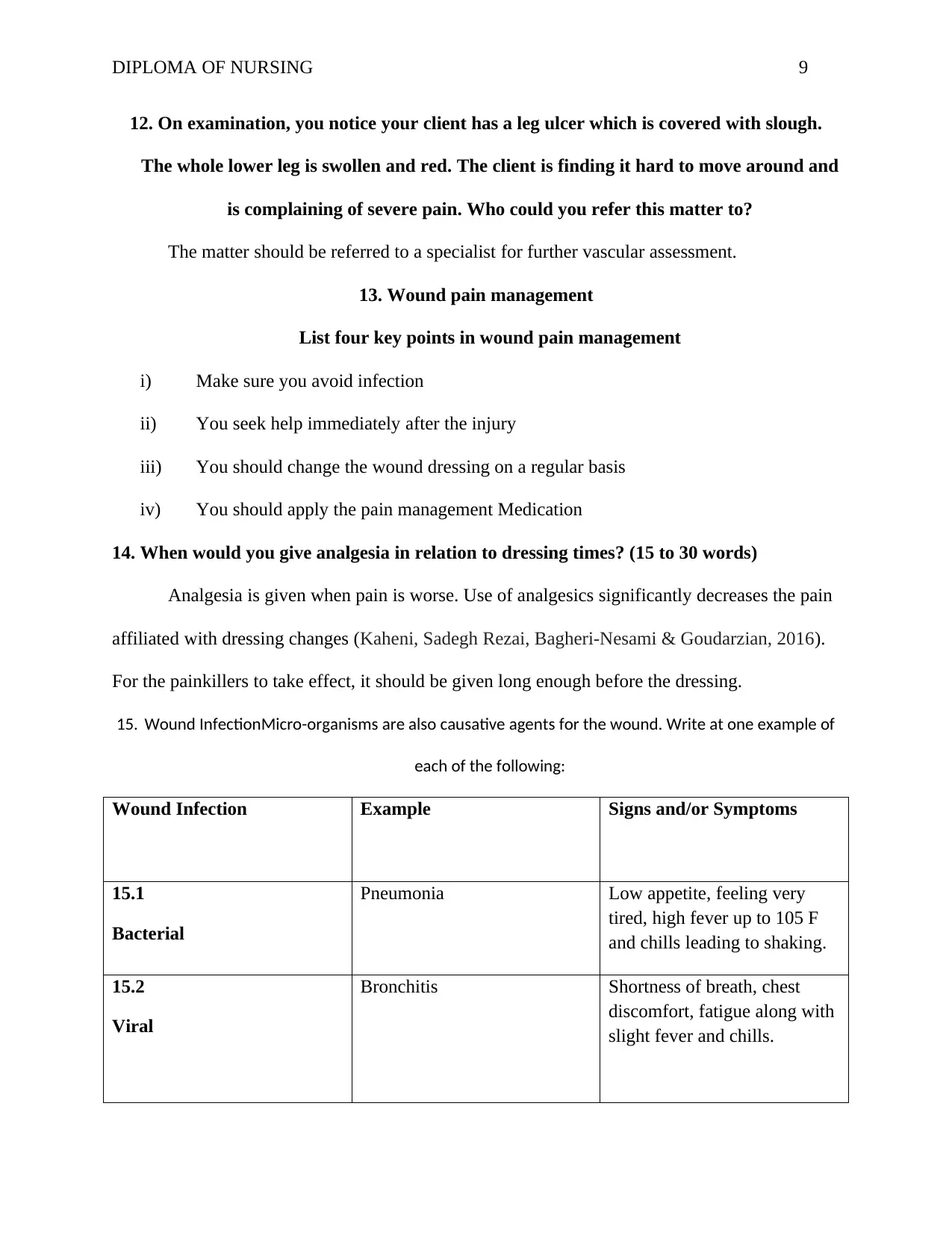
DIPLOMA OF NURSING 9
12. On examination, you notice your client has a leg ulcer which is covered with slough.
The whole lower leg is swollen and red. The client is finding it hard to move around and
is complaining of severe pain. Who could you refer this matter to?
The matter should be referred to a specialist for further vascular assessment.
13. Wound pain management
List four key points in wound pain management
i) Make sure you avoid infection
ii) You seek help immediately after the injury
iii) You should change the wound dressing on a regular basis
iv) You should apply the pain management Medication
14. When would you give analgesia in relation to dressing times? (15 to 30 words)
Analgesia is given when pain is worse. Use of analgesics significantly decreases the pain
affiliated with dressing changes (Kaheni, Sadegh Rezai, Bagheri-Nesami & Goudarzian, 2016).
For the painkillers to take effect, it should be given long enough before the dressing.
15. Wound InfectionMicro-organisms are also causative agents for the wound. Write at one example of
each of the following:
Wound Infection Example Signs and/or Symptoms
15.1
Bacterial
Pneumonia Low appetite, feeling very
tired, high fever up to 105 F
and chills leading to shaking.
15.2
Viral
Bronchitis Shortness of breath, chest
discomfort, fatigue along with
slight fever and chills.
12. On examination, you notice your client has a leg ulcer which is covered with slough.
The whole lower leg is swollen and red. The client is finding it hard to move around and
is complaining of severe pain. Who could you refer this matter to?
The matter should be referred to a specialist for further vascular assessment.
13. Wound pain management
List four key points in wound pain management
i) Make sure you avoid infection
ii) You seek help immediately after the injury
iii) You should change the wound dressing on a regular basis
iv) You should apply the pain management Medication
14. When would you give analgesia in relation to dressing times? (15 to 30 words)
Analgesia is given when pain is worse. Use of analgesics significantly decreases the pain
affiliated with dressing changes (Kaheni, Sadegh Rezai, Bagheri-Nesami & Goudarzian, 2016).
For the painkillers to take effect, it should be given long enough before the dressing.
15. Wound InfectionMicro-organisms are also causative agents for the wound. Write at one example of
each of the following:
Wound Infection Example Signs and/or Symptoms
15.1
Bacterial
Pneumonia Low appetite, feeling very
tired, high fever up to 105 F
and chills leading to shaking.
15.2
Viral
Bronchitis Shortness of breath, chest
discomfort, fatigue along with
slight fever and chills.
⊘ This is a preview!⊘
Do you want full access?
Subscribe today to unlock all pages.

Trusted by 1+ million students worldwide
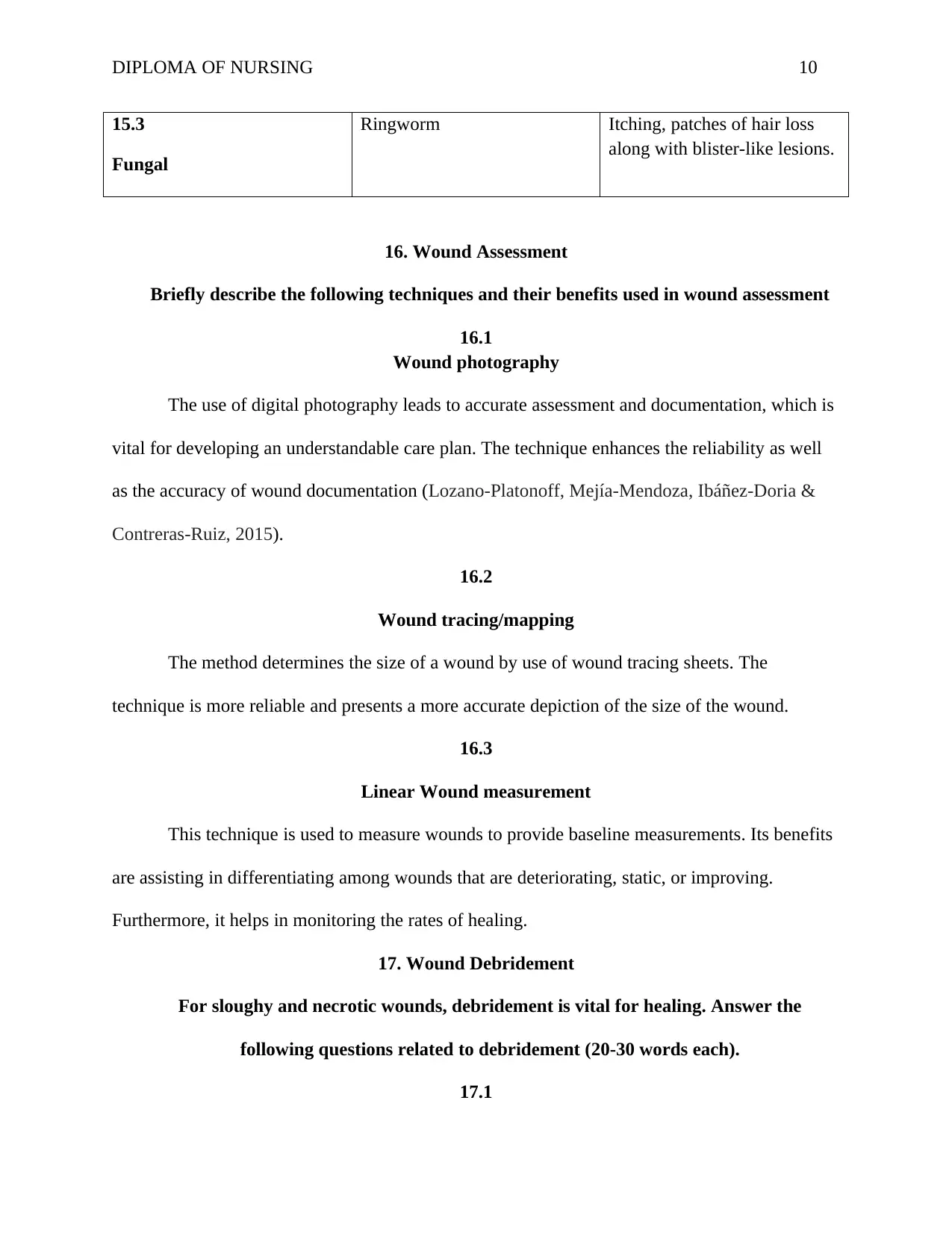
DIPLOMA OF NURSING 10
15.3
Fungal
Ringworm Itching, patches of hair loss
along with blister-like lesions.
16. Wound Assessment
Briefly describe the following techniques and their benefits used in wound assessment
16.1
Wound photography
The use of digital photography leads to accurate assessment and documentation, which is
vital for developing an understandable care plan. The technique enhances the reliability as well
as the accuracy of wound documentation (Lozano-Platonoff, Mejía-Mendoza, Ibáñez-Doria &
Contreras-Ruiz, 2015).
16.2
Wound tracing/mapping
The method determines the size of a wound by use of wound tracing sheets. The
technique is more reliable and presents a more accurate depiction of the size of the wound.
16.3
Linear Wound measurement
This technique is used to measure wounds to provide baseline measurements. Its benefits
are assisting in differentiating among wounds that are deteriorating, static, or improving.
Furthermore, it helps in monitoring the rates of healing.
17. Wound Debridement
For sloughy and necrotic wounds, debridement is vital for healing. Answer the
following questions related to debridement (20-30 words each).
17.1
15.3
Fungal
Ringworm Itching, patches of hair loss
along with blister-like lesions.
16. Wound Assessment
Briefly describe the following techniques and their benefits used in wound assessment
16.1
Wound photography
The use of digital photography leads to accurate assessment and documentation, which is
vital for developing an understandable care plan. The technique enhances the reliability as well
as the accuracy of wound documentation (Lozano-Platonoff, Mejía-Mendoza, Ibáñez-Doria &
Contreras-Ruiz, 2015).
16.2
Wound tracing/mapping
The method determines the size of a wound by use of wound tracing sheets. The
technique is more reliable and presents a more accurate depiction of the size of the wound.
16.3
Linear Wound measurement
This technique is used to measure wounds to provide baseline measurements. Its benefits
are assisting in differentiating among wounds that are deteriorating, static, or improving.
Furthermore, it helps in monitoring the rates of healing.
17. Wound Debridement
For sloughy and necrotic wounds, debridement is vital for healing. Answer the
following questions related to debridement (20-30 words each).
17.1
Paraphrase This Document
Need a fresh take? Get an instant paraphrase of this document with our AI Paraphraser
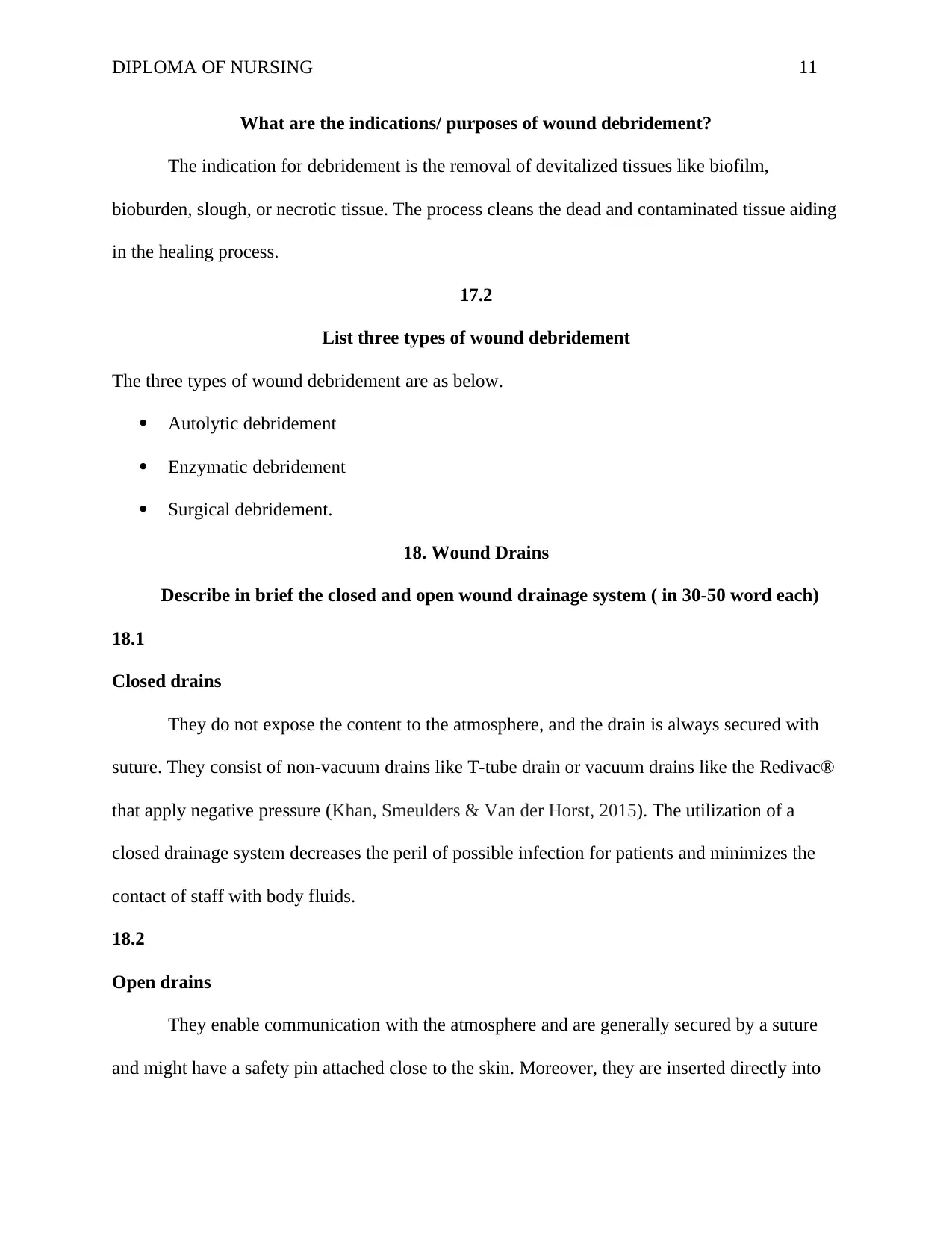
DIPLOMA OF NURSING 11
What are the indications/ purposes of wound debridement?
The indication for debridement is the removal of devitalized tissues like biofilm,
bioburden, slough, or necrotic tissue. The process cleans the dead and contaminated tissue aiding
in the healing process.
17.2
List three types of wound debridement
The three types of wound debridement are as below.
Autolytic debridement
Enzymatic debridement
Surgical debridement.
18. Wound Drains
Describe in brief the closed and open wound drainage system ( in 30-50 word each)
18.1
Closed drains
They do not expose the content to the atmosphere, and the drain is always secured with
suture. They consist of non-vacuum drains like T-tube drain or vacuum drains like the Redivac®
that apply negative pressure (Khan, Smeulders & Van der Horst, 2015). The utilization of a
closed drainage system decreases the peril of possible infection for patients and minimizes the
contact of staff with body fluids.
18.2
Open drains
They enable communication with the atmosphere and are generally secured by a suture
and might have a safety pin attached close to the skin. Moreover, they are inserted directly into
What are the indications/ purposes of wound debridement?
The indication for debridement is the removal of devitalized tissues like biofilm,
bioburden, slough, or necrotic tissue. The process cleans the dead and contaminated tissue aiding
in the healing process.
17.2
List three types of wound debridement
The three types of wound debridement are as below.
Autolytic debridement
Enzymatic debridement
Surgical debridement.
18. Wound Drains
Describe in brief the closed and open wound drainage system ( in 30-50 word each)
18.1
Closed drains
They do not expose the content to the atmosphere, and the drain is always secured with
suture. They consist of non-vacuum drains like T-tube drain or vacuum drains like the Redivac®
that apply negative pressure (Khan, Smeulders & Van der Horst, 2015). The utilization of a
closed drainage system decreases the peril of possible infection for patients and minimizes the
contact of staff with body fluids.
18.2
Open drains
They enable communication with the atmosphere and are generally secured by a suture
and might have a safety pin attached close to the skin. Moreover, they are inserted directly into
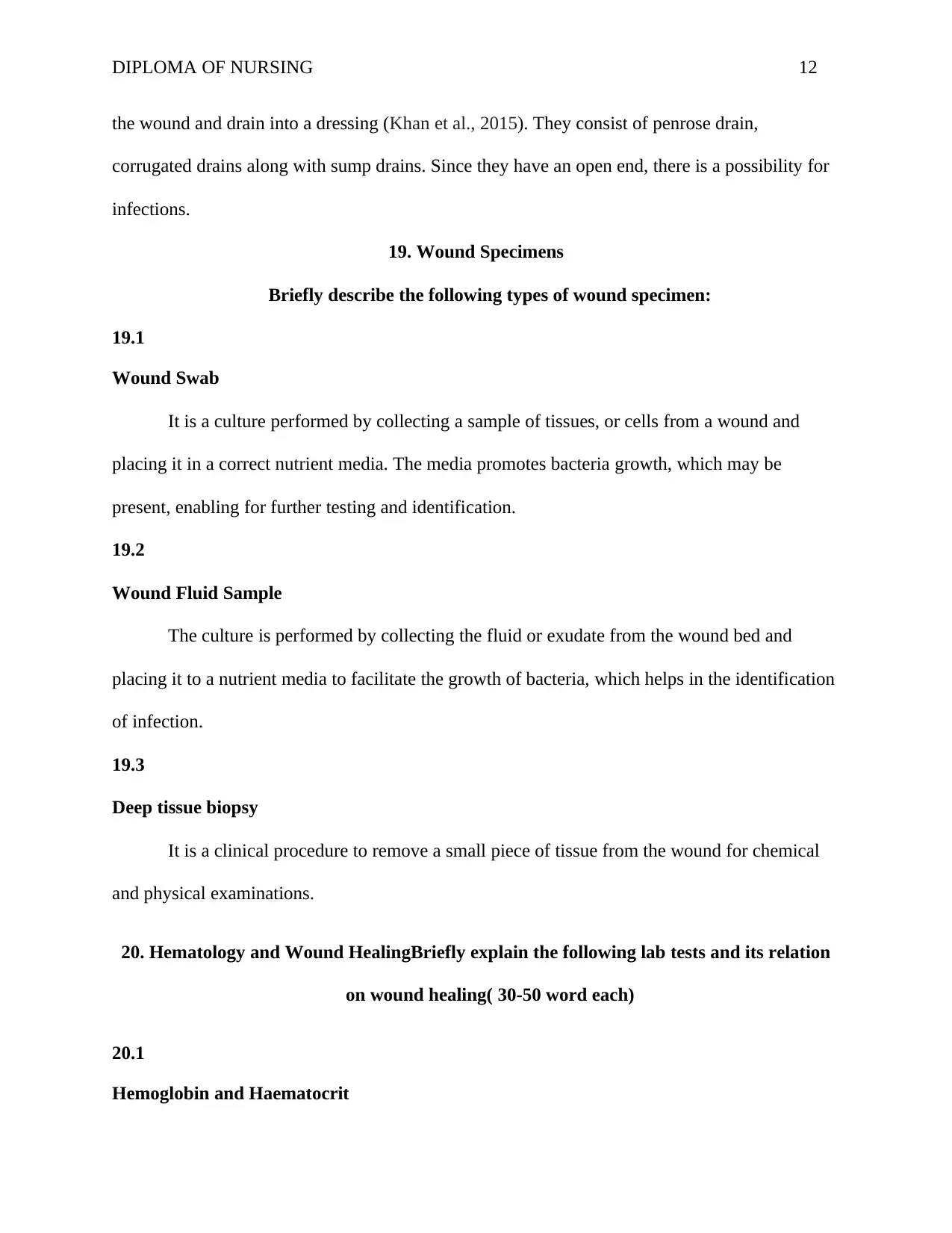
DIPLOMA OF NURSING 12
the wound and drain into a dressing (Khan et al., 2015). They consist of penrose drain,
corrugated drains along with sump drains. Since they have an open end, there is a possibility for
infections.
19. Wound Specimens
Briefly describe the following types of wound specimen:
19.1
Wound Swab
It is a culture performed by collecting a sample of tissues, or cells from a wound and
placing it in a correct nutrient media. The media promotes bacteria growth, which may be
present, enabling for further testing and identification.
19.2
Wound Fluid Sample
The culture is performed by collecting the fluid or exudate from the wound bed and
placing it to a nutrient media to facilitate the growth of bacteria, which helps in the identification
of infection.
19.3
Deep tissue biopsy
It is a clinical procedure to remove a small piece of tissue from the wound for chemical
and physical examinations.
20. Hematology and Wound HealingBriefly explain the following lab tests and its relation
on wound healing( 30-50 word each)
20.1
Hemoglobin and Haematocrit
the wound and drain into a dressing (Khan et al., 2015). They consist of penrose drain,
corrugated drains along with sump drains. Since they have an open end, there is a possibility for
infections.
19. Wound Specimens
Briefly describe the following types of wound specimen:
19.1
Wound Swab
It is a culture performed by collecting a sample of tissues, or cells from a wound and
placing it in a correct nutrient media. The media promotes bacteria growth, which may be
present, enabling for further testing and identification.
19.2
Wound Fluid Sample
The culture is performed by collecting the fluid or exudate from the wound bed and
placing it to a nutrient media to facilitate the growth of bacteria, which helps in the identification
of infection.
19.3
Deep tissue biopsy
It is a clinical procedure to remove a small piece of tissue from the wound for chemical
and physical examinations.
20. Hematology and Wound HealingBriefly explain the following lab tests and its relation
on wound healing( 30-50 word each)
20.1
Hemoglobin and Haematocrit
⊘ This is a preview!⊘
Do you want full access?
Subscribe today to unlock all pages.

Trusted by 1+ million students worldwide
1 out of 29
Related Documents
Your All-in-One AI-Powered Toolkit for Academic Success.
+13062052269
info@desklib.com
Available 24*7 on WhatsApp / Email
![[object Object]](/_next/static/media/star-bottom.7253800d.svg)
Unlock your academic potential
Copyright © 2020–2025 A2Z Services. All Rights Reserved. Developed and managed by ZUCOL.



